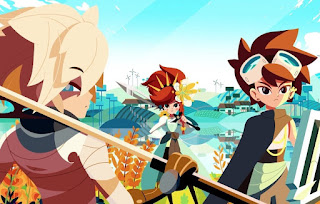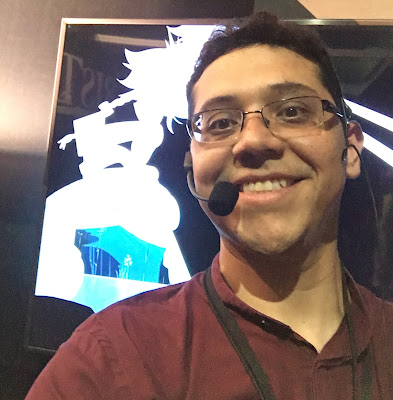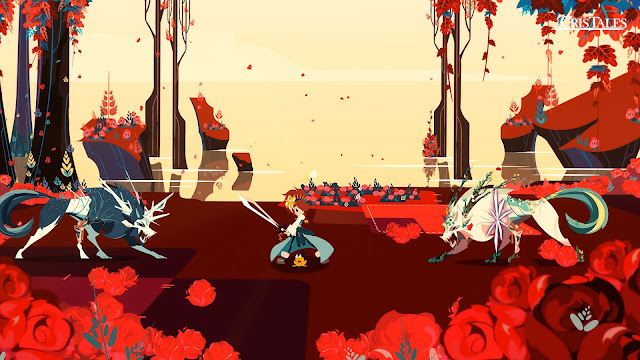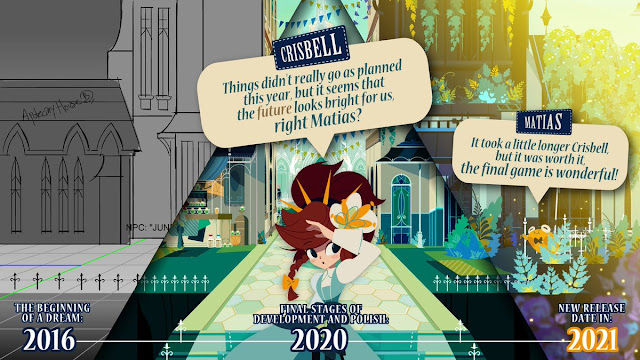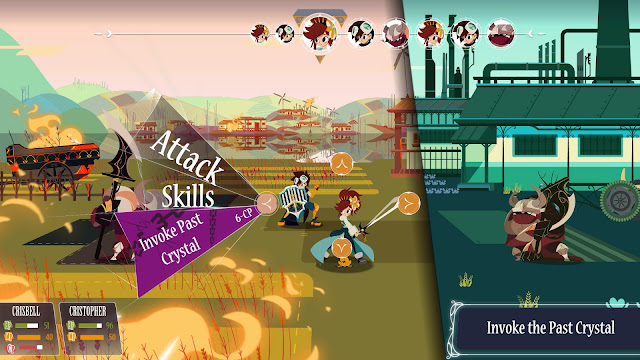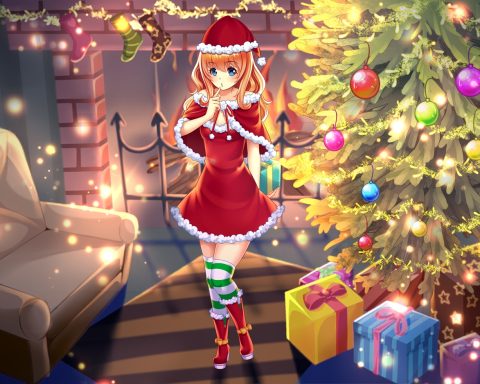If you haven’t heard of Cris Tales yet, I suspect you’re going to start hearing a lot about it quite soon. This grand homage from South America to the JRPGs of yesteryear (particularly Chrono Trigger), looks like the real deal, and then some. When so many “retro-inspired” games end up being hollow, shallow pastiches, this one, in development for many years now, looks like it not only wants to be inspired by the great games of yesteryear, but it wants to contribute to the tradition in a meaningful way, too.
Carlos Rocha Silva: Wow, thanks for making it easy then! I’m Carlos Rocha, CEO of Dreams Uncorporated, and to be honest, it was more of a natural progression of events. We never even started with the idea of making an RPG, much less one inspired by one of our favourite games. It was a combination of elements: we first came up with the idea of the crystals and time, and how those things could interact in different genres, then we decided on RPGs as the way to better use the concept of the crystals in combat. So then, time manipulation, RPGs, and that’s how we arrived at the RPG with a time travel mechanic – it wasn’t a planned thing.
Matt S: Do you feel that openly comparing yourself to Chrono Trigger is setting yourself a heck of a shadow to step out from?
Carlos Rocha Silva: It is! But as I mentioned, we didn’t decide to make it that way, it was part of the creative process. We don’t see it necessarily as a bad thing, but it was definitely scary to talk about it as such. And even after those comparisons, people still seem to like it a lot! That’s actually scarier, to live up to the hype people already have with the game from the trailers and demos, not so much from the comparisons. We don’t expect to be the successor of Chrono Trigger, or Final Fantasy 6, but we do want people to enjoy this new approach to JRPGs.
Matt S: The early response seems to be positive. Has anything about the response surprised you?
Carlos Rocha Silva: Everything, really. We never expected people to be so excited about the game, and every time we share something new, a lot more people get excited about it, so it’s a virtuous circle! Although it’s hard to find the balance between trying to show people how everything is going, and focus on working on so many things the team still wants to put in the game. But back to the question, we will say that the incredible response from Japan was extremely motivating, and it drives us forward, to give the best experience to the players as we can. So maybe that was the biggest surprise out of all the surprises.
Matt S: I’ve loved seeing the growth of the game development scene across South America for the way it has given game developers a chance to share their cultures with the world. Are we going to get any uniquely Colombian insights, thoughts, or philosophies in Cris Tales?
Carlos Rocha Silva: Oh yes, most definitely. The game even has something we like to call Endemic Fantasy, which is our way of reversing the Magical Realism that many Colombian writers use, which is to take magical elements, and make them everyday happenings. In our take, we take everyday elements from our culture, architecture, fauna and flora, and put it into this fantasy world. You will find a cathedral made out of salt, which is based on a real cathedral made out of salt from Colombia, or how Matías, the little frog companion of Crisbell is based on the Colombian golden frog, a very poisonous frog in real life! Crisbell’s own hometown, Narim, is based on the real place Nariño, and specifically, Ipiales, where you will find a very similar cathedral to the one in the game.
But you asked about something very unusual – philosophies – and, to be honest, yes, from the narrative standpoint, we want to show a lot of contrasting thoughts in Colombian culture. What do people prioritise sometimes, what are the conflicting mindsets and how often those result in serious and social issues. We really want to show a lot of Colombia in the game, and for someone who wants to learn more, it will be a very thought-provoking experience.
Matt S: The aesthetic is gorgeous. Where did it come from?
Carlos Rocha Silva: Well, it came from Sebastian Villareal, the art director. He wanted to create a new aesthetic that represented the uniqueness of the game, while answering the question: how would a Disney princess look if she was Colombian? Of course, using a lot of personal influences like Eyvind Earle or even modern cartoons like Samurai Jack to create their own world.
From there, he also used his background in the world of a traditional animator, and defined not only the unique art style, but also the special take on the type of animation the game uses, which is done mostly frame by frame in a traditionally animated style. We’re really glad people from all over the world are enjoying the look and feel of the game!
Carlos Rocha Silva: Well, to be honest, it’s to live up to the expectations. For starters, we’re a Colombian based studio, so more than a JRPG, it’s a sort of a Colombian take on the JRPG genre. We are deeply moved by the people around the world, especially from Asia and Japan of course, and how much they’ve told us the game feels like someone who really understands the genre. But we are also cautious: we want to see how people actually react to the full experience, the full game, and we want to live up to the hype, which is not going to be easy (especially not after that great Nintendo Indie World, Japan edition!).
But from a technical standpoint, it’s some decisions we made that were difficult to pull off, even if we believed they were completely worth it. One is the three time periods at the same time of course, because we not only had to make things three times, but sometimes five or six times! That’s because the future changes depending on some choices you make, so there are different outcomes to the different towns you encounter and how you end up trying to improve the town itself.
Also, traditional animation takes a really long time… All of this has to be supported by really solid design, because you need to know where things go and how do they connect. And, of course, to finally put all of this into the game, and implement the different possibilities and make it work as polished as time allows us to.
Matt S: The JRPG never went away, but it is fair to say that it went through a quieter period. Now, though, it’s in one of the healthiest positions it has ever been. What do you think has been responsible for the current interest in the genre?
Carlos Rocha Silva: It’s really difficult to say, but whatever the bug seems to be, it seems to have bitten us too, and at a very good time as you point out! We have been making this game for three years, and the concept was born five years ago, so we’ve had the idea of making this RPG for quite some time. But it’s not completely coincidental: a lot of things are coming back from the old days, but with a new look. We’ve always been fans of manga, old movies, old music groups, and the number of remakes, reimaginings, and music band reunions are something we have been fortunate enough to be experiencing right now. As for classic JRPGs, you can even play Final Fantasy 6 or Earthbound on the mini-SNES (which I own and it’s awesome), along with so many classic games.
I think it’s also expected: a lot of us current creators grew up enjoying all of this art, being inspired by it, influenced by so many diverse elements, that we eventually were going to give back to the world in the same art form as it reached us, but mixed with our own personal experiences and perspectives.
Matt S: Why was “time” such an important motif to you in Cris Tales?
Carlos Rocha Silva: Because it was the central mechanic, and as a game designer, I’m a slave to concept. So based on that original concept, everything else was derived from that core idea. And the relation to time was there even before we decided to turn it into an RPG! Learn from the past, act in the present, create your future. That’s the main philosophy of the game, and it permeates everything in it, from the NPCs (which are all unique and each tells a short story in itself) to the enemies, which can be stronger or weaker in either the past, the future, or in the present!
It’s all an interconnected world where we hope people can explore the dynamics between the mechanics and the choices they can make through the experience. Each character was created thinking what was their relationship with the core mechanic, and based on that, their personalities, their way of fighting, even their looks was based on that relationship.
Matt S: Finally, outside of the games that inspired Cris Tales directly, what JRPGs would you recommend to players, and why?
Carlos Rocha Silva: I’m sure some team members will mention Dark Souls, even controversially: it is an RPG, even if not turn-based. On that same line, Action-JRPGs would be Nier Automata, which has an absolutely incredible story.
It’s hard because we use so many JRPGs as reference, but outside the ones we have mentioned, the Dragon Quest series of course, Xenoblade Chronicles, and from the old days, we also recommend the original Xenogears. And, well… most of the others we actually used as references, so I guess we can’t mention them. But mostly, play Cris Tales this July 20!
– Matt S.

